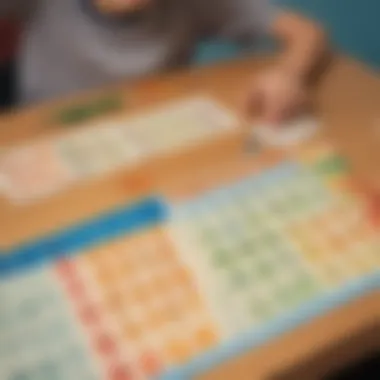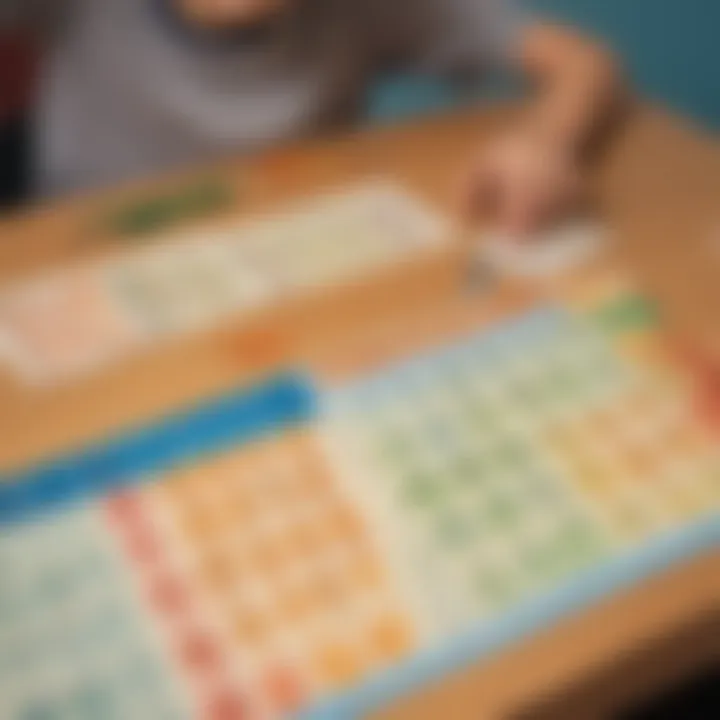Mastering the Times Table of Eight for Kids


Intro
Understanding multiplication is crucial for elementary school children. It lays the foundation for advanced math concepts and practical problem-solving skills. The times table of eight is one important aspect of this journey. By exploring its patterns and practical uses, we can make math both accessible and enjoyable for young learners.
The multiplication of eight is a vital skill. It plays a significant role in many everyday tasks, such as shopping, cooking, and budgeting. Learning this specific times table can sharpen mental math skills and boost confidence. In this article, we will break down the times table of eight into engaging methods and interactive activities to help children learn effectively.
Prolusion to the Times Table
Understanding the times table is crucial for young learners. This topic lays the foundation for advanced mathematical concepts. Knowing multiplication can help children solve problems more efficiently in their daily lives. The times table specifically for eight is one that is often used in various scenarios.
The benefit of mastering this times table extends beyond mere memorization. It leads to improved confidence in handling numbers. When children learn the times table, they develop a key skill that enables them to tackle more challenging topics in math later on. It prepares them to understand more complex operations like division, fractions and even algebra.
Multiplication is often referred to as repeated addition. Each entry in the times table represents a certain number of groups. For example, the table of eight shows how many total objects there are when you have groups of eight. This comprehension transforms abstract numbers into relatable concepts.
There are also many practical aspects to the times table of eight which resonate with real-life applications. To grasp these real-world applications, it is helpful to first understand the fundamental purpose of multiplication itself.
The Times Table of Eight Explained
The times table of eight is a crucial foundation in understanding multiplication. It serves as a building block for more advanced math concepts. By mastering this table, students can improve their overall numerical skills. This section will cover important elements, benefits, and considerations related to the times table of eight.
Fundamentals of the Times Table of Eight
The basics of the times table of eight include the products generated by multiplying eight with different whole numbers. Here are the core values:
- 1 × 8 = 8
- 2 × 8 = 16
- 3 × 8 = 24
- 4 × 8 = 32
- 5 × 8 = 40
- 6 × 8 = 48
- 7 × 8 = 56
- 8 × 8 = 64
- 9 × 8 = 72
- 10 × 8 = 80
Knowing these products is essential for performing calculations efficiently. Understanding how each multiplier corresponds to a specific result helps reinforce pattern recognition in mathematics. The eight times table can also be used to calculate larger values by building upon these core products. For example, multiplying eight by larger numbers can often leverage the learned values for quicker results.
Visual Representation of the Times Table of Eight
Visual aids assist in memorizing the times table of eight. A grid or chart showing the products provides an easy reference. Here’s an example of a simple layout:
| Multiply by | Result | | 1 × 8 | 8 | | 2 × 8 | 16 | | 3 × 8 | 24 | | 4 × 8 | 32 | | 5 × 8 | 40 | | 6 × 8 | 48 | | 7 × 8 | 56 | | 8 × 8 | 64 | | 9 × 8 | 72 | | 10 × 8 | 80 |
Additionally, many students benefit from color coding or grouped numbers to visualize patterns. For instance, if we look closely, we can see that each result increases by eight, creating an easily recognizable sequence. Utilizing both numerical and visual strategies can enhance a child's ability to retain information about multiplication, making learning more effective.
"The key to learning multiplication lies in practice and visualization. Engaging with the times table helps solidify understanding and application."
By combining these fundamentals and visual representations, students can approach the times table of eight with confidence, laying the groundwork for advanced mathematical reasoning.
Learning Techniques for Mastering the Times Table
Repetition and Practice
Repetition and practice are crucial elements for learning the times table of eight. This technique helps reinforce knowledge. Regular practice ensures that the facts become second nature. For example, students can write or recite the times table repeatedly. This can involve doing exercises that encourage recall, such as flashcards or timed drills. Spending time practicing will solidify the multiplication facts in their minds and assist in quicker retrieval when needed.
"Practice does not make perfect. Only perfect practice makes perfect."
Consistency plays a key role in this process. Setting aside a few minutes each day for deliberate practice can lead to significant improvements over time. Moreover, this method is adaptable. Teachers and parents can help by creating engaging drills that maintain interest while focusing on core multiplication skills.
Games and Activities
Incorporating games and activities into learning makes understanding the times table enjoyable. Learning through play captures children's attention and motivates them to engage with numbers willingly. Board games and card games specifically designed for teaching multiplication can lead to deep understanding. For instance, there are games that require players to solve multiplication problems to advance.
Additionally, digital resources and apps can provide interactive experiences. These often include challenges, timed quizzes, and even online leaderboards that create a sense of competition. Such aspects can very motivating, especially for younger learners.
Furthermore, cooperative learning activities can be effective. Group exercises, where students work together to solve problems or quiz each other, promote both social engagement and mastery of multiplication facts.


Mnemonics and Memory Aids
Mnemonics and memory aids serve as powerful tools for learning multiplication. These techniques simplify complex information into manageable chunks. For example, students can create rhymes or songs that embed the times table of eight into a melody. This captures the rhythm of the facts, making them easier to remember.
Other visual aids, such as charts or diagrams, can provide helpful reference points. A chart of multiples of eight displayed prominently helps reinforce memory through visual learning. Students can also use colors to highlight patterns such as the last digits of products in the eight times table: 8, 6, 4, 2, and 0.
Moreover, mnemonic devices can link ideas together. For instance, associating eight with an octagon helps students remember that eight is related to groups of eight. This type of association can create a scaffold upon which deeper understanding is built.
In summary, mastering the times table of eight requires a blend of structured repetition, engaging activities, and creative memory aids. By employing these techniques, students can gain confidence in their abilities. This confidence not only impacts their performance in school but also sets the stage for future mathematical concepts.
The Multiplicative Identity and Its Role
The concept of the multiplicative identity is a fundamental aspect of mathematics that plays a crucial role in understanding multiplication, including the times table of eight. The multiplicative identity is the number one, which means that when any number is multiplied by one, the product remains unchanged. This property is essential for students to grasp as it provides a foundation for more complex mathematical concepts.
Understanding the Concept of One
The number one is not just a number; it is a powerful tool in multiplication. It helps in maintaining the value of the original number. This idea can be illustrated with a simple example: when you multiply 8 by 1, you get 8. Here, the task remains unchanged.
Empowering students with the knowledge of the multiplicative identity enables them to perform calculations more confidently. Recognizing that multiplying by one doesn't affect the original number can also simplify their mental math process. Children can apply this understanding when tackling the times table of eight by remembering that every calculation involving one can be done effortlessly.
"The number one is like a steady anchor in the ocean of numbers. It keeps values stable and helps learners build their mathematical skills."
Knowing about the multiplicative identity can also lead to better problem-solving capabilities. It serves as a reminder that not all operations lead to changes in value. Students can use this concept in various math scenarios, enhancing their overall number sense.
In summary, the multiplicative identity, represented by the number one, is not just a basic arithmetic fact; it is a stepping stone for understanding multiplication. Mastery of this concept is necessary for young learners, especially when they face the times table of eight. It enables them to solve problems efficiently and with greater accuracy while building a strong foundation for more advanced material.
Patterns in the Times Table of Eight
Understanding patterns in the times table of eight enriches learning and helps in mastering multiplication. Recognizing these patterns provides not only a mathematical connection but also a foundation for future learning. Patterns maintain structure and predictability in the learning process, essential for children as they progress in their educational journey.
Recognizing Regularities
The times table of eight displays several regularities. For instance, if we observe the sequence:
- 8, 16, 24, 32, 40, 48, 56, 64, 72, 80
Each number is consistently added by eight. This predictable increment is a cornerstone for children to grasp, making multiplication less daunting.
Children can also note the last digit of each product. If the last digit is 0, 8, 6, 4, 2, it follows a steady cycle:
- 8 ✅
- 6 ✅
- 4 ✅
- 2 ✅
- 0 ✅
By identifying these regularities, they can work more efficiently, gaining confidence.
Utilizing Patterns for Quick Calculations
Recognizing these patterns simplifies calculations significantly. For example, if a student needs to solve 8 times 7, they can recall that it is one step from 8 times 6. Thus, they can quickly adjust by adding 8 again rather than starting from scratch.
Some strategies include:
- Breaking Down Multiplications: If students remember basic multiples, like 8 times 10, they can break it down:
- Doubling Strategy: Since 8 is double 4, students can multiply by 4 first and then double it:
- 8 times 10 is 80.
- For 8 times 7, subtract one group of 8 from 80 to get 72.
- 4 times 7 is 28.
- 28 doubled becomes 56.
These approaches reinforce understanding and provide pathways to perform quick calculations. The relationship among numbers in the times table of eight not only makes learning fun but also practical.


"Recognizing patterns is not just an advantage in arithmetic; it is a skill for lifelong learning in mathematics."
The ability to see connections fosters stronger problem-solving skills in diverse mathematical contexts. Emphasizing these strategies equips children with the tools they need to navigate their academic future confidently.
Practical Applications of the Times Table of Eight
One key benefit is the way multiplication with the number eight facilitates rapid calculations. Students can easily grasp how to calculate total amounts when dealing with items sold in groups of eight. Consider buying packs of beverages; if each pack contains eight cans, knowing how to multiply can prevent the need for excessive counting. This not only boosts confidence but also enhances efficiency in tasks.
Everyday Situations Involving the Times Table of Eight
Everyday experiences often involve the times table of eight without learners realizing it. Here are some common situations:
- Cooking: Recipes may call for certain ingredients in multiples of eight. If a recipe for pancakes requires eight eggs, multiplying becomes vital if adjusting servings.
- Shopping: When purchasing items such as pencils or markers, they might be packaged in quantities of eight. Recognizing how many packs equate to a specific number helps consumers make informed choices.
- Transportation: When sharing rides, knowing how many people can fit in a vehicle divided by eight helps in organizing groups efficiently.
In each of these situations, applying the times table of eight supports smooth operations.
Application in Real-World Problems
In addition to basic everyday tasks, the times table of eight is essential in solving real-world problems. Here are illustrations:
- Budgeting: If a family budgets eight dollars for each lunch's expense over a week, knowing how to calculate the total quickly saves time. Multiplying eight by five leads to a total of forty dollars for lunches, allowing better financial planning.
- Event Planning: For events where tables seat eight individuals, planning becomes simpler when multiplying the number of tables by eight to estimate the total number of attendees.
- Sports: In team sports, understanding how many players are needed for a certain number of teams can often require knowledge of the times table of eight.
Utilizing the times table of eight can clarify situations that might otherwise seem complicated.
"Mastering basic multiplication, like the times table of eight, is a cornerstone for more advanced mathematical concepts."
Mental Math Techniques
Mental math techniques are essential for developing strong arithmetic skills. They allow students to solve mathematical problems quickly without relying on calculators or pencils. This part of the article will provide strategies that enhance cognitive processing and memory skills, making multiplication, especially the times table of eight, easier to understand and recall.
Mental math encourages a deeper understanding of numbers, helping learners visualize the relationships between them. Students who master these techniques tend to perform better in math, benefiting from improved confidence and efficiency in problem-solving. By focusing on mental calculations, learners cultivate their ability to think on their feet and tackle complex problems.
Strategies for Quick Recall
One key element of quick recall is repetition. Students should regularly practice the times table of eight, repeating each equation until it becomes second nature. Using flashcards can be an effective way to drill these facts regularly. Each card presents a problem, such as "8 x 3 = ?", allowing users to answer quickly.
In addition, encouraging learners to engage in peer-teaching can promote stronger retention. When they explain concepts to each other, they also reinforce their understanding. Setting up fun competitions or timed sessions can transform practice into a more engaging activity.
Some students find it helpful to form associations between numbers. For example, noting that 8 x 5 equals 40 may lead them to remember that 8 x 6 is simply adding another 8, giving 48.
Using Multiplication to Solve Complex Problems
Understanding multiplication as a repeated addition is vital for solving more complex problems. When students can visualize multiplication as groups, they can break down challenging equations into simpler parts. For example, in a scenario where a recipe requires adjustments for 8 servings, students can multiply to find out how much of each ingredient is needed without extensive calculations.
Real-life applications, such as budgeting or cooking, demonstrate the utility of multiplication. For instance, if a block of cheese costs $8 and someone wants five blocks, the quick mental math technique would be to recognize it as 8 x 5, yielding a total of $40. This can be powerful for understanding expenses.
Mental math transforms the way we approach numbers, making math feel less intimidating and more applicable.
By engaging with multiplication on a practical level, students learn not just the times table of eight but also the foundational skills that enhance their overall mathematical ability. As they become adept at mental calculations, students gain confidence, prepare for more advanced math, and develop essential skills for their daily lives.
Common Mistakes with the Times Table
Understanding common mistakes within the times table of eight is crucial for learners. Identifying these errors can help students improve their multiplication skills and build confidence. Even a small mistake in multiplication can lead to larger problems down the line. By addressing these issues early, students can establish a solid foundation in mathematics.
Identifying Calculation Errors
Calculation errors often arise in simple multiplication tasks. For example, a student may mix up their digits or miscalculate a number. It is essential to pay attention to these errors, as they can become habitual if not corrected. Here are several common calculation errors:


- Transposition Errors: Switching numbers around, such as thinking 8 times 6 is 48 instead of 54.
- Skipping Steps: Jumping directly to the answer without checking the process can lead to mistakes.
- Misunderstanding Zero: Failing to recognize that multiplying by zero results in zero.
By helping learners recognize these types of mistakes, we can encourage a more thorough understanding of multiplication.
Strategies to Avoid Mistakes
To avoid these calculation errors, there are several strategies that can be put into practice. Teachers and parents can guide children through these helpful steps:
- Practice Regularly: Frequent practice solidifies understanding. Repetition can help minimize errors.
- Work Slowly: Rushing through problems often leads to mistakes. Encourage kids to take their time with each multiplication problem.
- Double-Check Work: After solving a problem, students should verify their answers. This can catch small errors before they become ingrained habits.
- Use Visual Aids: Tools like multiplication charts can help visualize relationships and validate answers.
"Mistakes are proof that you are trying. Learning from them is key to improving in math."
These strategies are simple but effective. By focusing on identifying mistakes and implementing preventive measures, learners can enhance their multiplication abilities. Proper guidance can lead to stronger mathematics skills that students will carry with them into more advanced topics.
Engagement Strategies for Young Learners
Engagement strategies are vital when teaching the times table of eight to elementary school children. These strategies help to foster an environment where learning becomes active and enjoyable. The goal is to move beyond rote memorization, encouraging children to explore multiplication concepts in a meaningful way. Engaging children can enhance their understanding and retention of mathematics. Adopting these strategies contributes significantly to building their confidence and interest in the subject.
Key elements of successful engagement include creating interactive experiences, fostering collaboration among peers, and utilizing technology effectively. When students are active participants in their learning, they tend to develop a more positive attitude toward math. This engagement not only aids in mastering the times table of eight but also lays a foundation for future mathematical skills.
Interactive Learning Tools
Interactive learning tools are essential to engage young learners in the mastery of the times table of eight. These tools can range from physical manipulatives to digital applications. Here are a few options:
- Flashcards: Simple yet effective, these can help reinforce multiplication facts through repetition and visual aids.
- Games: Math-based games, whether played in the classroom or online, can stimulate interest. Consider using games like multiplication bingo, which can present facts in a fun manner.
- Apps: There are many educational apps designed for children that focus on multiplication. These apps often include engaging visuals and rewards that can motivate students.
Implementing these interactive tools can make learning more dynamic. Children often respond well to hands-on activities, allowing them to see the relevance of math in a playful context.
Incorporating Technology in Learning
Technology plays a significant role in modern education. Its incorporation into learning strategies for the times table of eight can provide enhanced opportunities for engagement. Here are some considerations:
- Online Resources: Websites like en.wikipedia.org and britannica.com provide valuable information and interactive content that can help deepen understanding.
- Educational Videos: Many platforms offer videos demonstrating multiplication concepts. These visual representations can help students grasp the ideas better.
- Interactive Websites: Websites that allow students to practice multiplication in a game format can improve their skills in a low-pressure environment.
Incorporating technology enables children to learn at their own pace. Also, it provides additional resources that can help clarify concepts when necessary. Encouraging students to utilize these tools can greatly improve their comfort with mathematics and bolster their overall skills.
With the right engagement strategies, learning the times table of eight becomes an exciting journey rather than a tedious task.
Through interactive tools and technology, young learners can build a strong foundation in multiplication, setting the stage for future success in mathematics.
The End and Future Learning
As children continue their educational journey, ongoing practice becomes vital. Parents and caregivers can facilitate this by encouraging regular review and reinforcing newly learned skills. Engaging in math with enthusiasm shows children that mathematics is not only important but also enjoyable. By pursuing continuous learning in mathematics, children can develop confidence and achieve greater proficiency as they advance in their studies.
"Mathematics, rightly viewed, possesses not only truth but supreme beauty."
Encouraging Continued Practice
Encouragement is key in mastering the times table of eight. Consistent practice can take various forms. Some effective methods are:
- Regular Review: Short, daily sessions can improve memory retention.
- Fun Games: Incorporating games that reinforce multiplication can make learning enjoyable.
- Group Study: Encouraging children to learn in pairs can promote collaborative problem-solving.
Finding creative ways to integrate multiplication into daily life enhances skill retention. For example, parents might use cooking to practice multiplication by doubling recipes. Such real-world applications make the learning process more meaningful, showing children the relevance of what they are learning.
Exploring Advanced Multiplicative Concepts
Once children have mastered the times table of eight, it opens doors to more complex mathematical concepts. Engaging with advanced topics helps children draw connections between different areas of math. Some of these concepts include:
- Factors and Multiples: Understanding how numbers relate to each other supports further exploration in number theory.
- Fractions and Ratios: Multiplication is fundamental in learning how to work with fractions and ratios effectively.
- Algebraic Expressions: Early exposure to multiplication lays the groundwork for basic algebra skills.
Parents and educators can help children transition into these advanced topics by providing the necessary support and resources. Online platforms, such as educational websites like en.wikipedia.org or britannica.com, can offer additional learning materials and explanations that clarify these concepts.
In summary, mastering the times table of eight is just the beginning. Continued practice and exploration of advanced concepts not only enrich mathematical understanding but also prepare learners for future academic success.







